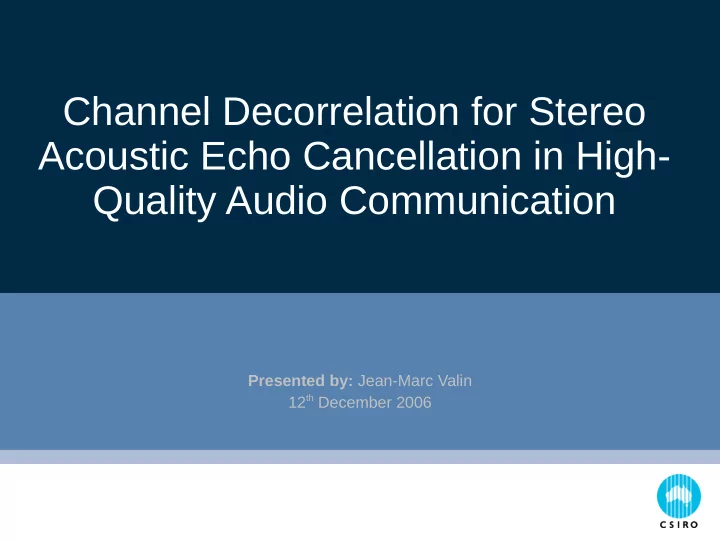

Channel Decorrelation for Stereo Acoustic Echo Cancellation in High- Quality Audio Communication Presented by: Jean-Marc Valin 12 th December 2006
How to Corrupt an Audio Signal and Get Away With It Presented by: Jean-Marc Valin 12 th December 2006
Introduction www.ict.csiro.au Context: acoustic echo cancellation with stereo signals Problem: channels in a stereo signal are highly-correlated Approach: decorrelate channels by altering the received audio
Overview www.ict.csiro.au Stereo acoustic echo cancellation is generally ill-conditioned If inter-channel coherence is high, the acoustic impulse response cannot be unambiguously identified Solution: reduce coherence before playback without affecting quality Popular implementation: memoryless non-linearity loudspeakers left right adaptive echo room acoustics ^ w k ( n ) canceller estimated echo echo - double-talk + and noise + output microphone (to remote end)
Overview www.ict.csiro.au Stereo acoustic echo cancellation is generally ill-conditioned If inter-channel coherence is high, the acoustic impulse response cannot be unambiguously identified Solution: reduce coherence before playback without affecting quality Popular implementation: memoryless non-linearity loudspeakers left right adaptive echo room acoustics ^ w k ( n ) canceller estimated echo echo - double-talk + and noise + output microphone (to remote end)
Overview (cont.) www.ict.csiro.au Goals Reduce coherence at all frequencies Keep noise (nearly) imperceptible Preserve stereo image Low delay Considering Psychoacoustic masking Deafness to phase (single ear only) Interaural Phase Difference (IPD) as an important low-frequency localisation cue
Overview (cont.) www.ict.csiro.au Proposed Time-varying all-pass filter with phase distortion only at higher frequencies Psychoacoustically-masked noise in the whole band Allpass fjlter Decorrelated Input audio audio + Noise generator psycho- Masking acoustic curve model
Allpass Filtering www.ict.csiro.au Flat amplitude response, non-linear phase response General form hard to design, instead comb-allpass filter Needs to be time-varying Both N and α Held constant over a frame, apply weighted overlap-add (WOLA)
Shaped Comb-Allpass (SCAL) Filtering www.ict.csiro.au Why not “shape” the phase response to minimise phase distortion at low frequency?
Psychoacoustically-Masked Noise www.ict.csiro.au The human ear sometimes cannot perceive noise when there are other noise or tone signals (simultaneous masking) Can be exploited to inject imperceptible noise Using masking curve from the Vorbis audio codec (with minimal additional tuning) Exploits simultaneous masking Curve computed in the frequency domain and used to shape a white noise signal Weighted overlap add (WOLA) Noise is delayed to eliminate delay (exploiting temporal masking)
Evaluation www.ict.csiro.au Comparing with Smoothed absolute value (best memoryless non-linearity) First-order all-pass filter (filter coefficients change every sample) Stereo processing from mono input 44.1 kHz Four music samples, four speech samples Coherence measured as: Averaged over critical bands (Bark scale) Quality evaluated with PEAQ (validated with informal MUSHRA- like test)
Results www.ict.csiro.au } proposed } smoothed abs 1 st ord. allpass
Results (cont.) www.ict.csiro.au SNR measure on a guitar sample (nearly transparent quality)
Audio Artifacts (Worst Examples) www.ict.csiro.au Smoothed absolute value Inter-modulation distortion on tonal audio “Ping-pong” stereo effect on impulsive audio First order allpass filter High-frequency crackling noise (first-order allpass) Proposed (allpass+noise) Mild stereo “flanging”
Conclusion www.ict.csiro.au Observation: it is surprising how much abuse an audio signal can take No sensitivity to high frequency phase De-correlation method: Shaped comb-allpass filter for high frequencies Wideband psychoacoustically masked noise Both more effective and better quality than other methods Next step: measure improvement in stereo acoustic echo cancellation context
Questions??? www.ict.csiro.au
Recommend
More recommend